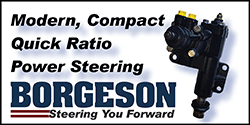New stock rebuild 318 for my ramcharger, Other than a spreadbore Holley. At idle my EGR is opening up. I've tried 2 different egr valves and 2 different ported vacuum switches. Even the ones off the old engine open at idle. Can I not use egr with the holley?
EGR open at idle
- Thread starter gliderider06
- Start date
-
Do you need EGR to pass smog?
I will next summer, but I want to retain it irregardless. I hope to get better mileage with it operational.
EGR pollutes the incomming air charge with exhaust gas so if anything it will reduce your milage.
It is a smog reduction device.
Regarding it's operation, is the valve that controls the vacuum to the EGR electronically controlled?
It is a smog reduction device.
Regarding it's operation, is the valve that controls the vacuum to the EGR electronically controlled?
Mattax
Just the facts, ma'am
OK. I think that confirms what we thought was the problem in your other thread.
Same carb as pictured in the other thread but the other primary.
At slow idle: See about .025 - .30" of the transfer slot and also the idle port.

Off-idle or idle position set too far open: Notice the additional port. That goes to the ported vacuum on the side of the primary metering block.

Same carb as pictured in the other thread but the other primary.
At slow idle: See about .025 - .30" of the transfer slot and also the idle port.
Off-idle or idle position set too far open: Notice the additional port. That goes to the ported vacuum on the side of the primary metering block.
Mattax
Just the facts, ma'am
While it was usually used for vacuum advance, if that's the only ported source on that carb (typical of many aftermarket Holley's), use a Tee in the vacuum line.
An explanation from Chrysler Tech on this page
Ignition Systems, Master Technician's Service Conference: Vacuum Advance.
An explanation from Chrysler Tech on this page
Ignition Systems, Master Technician's Service Conference: Vacuum Advance.
Sorry, I had a brain fart with this. On the old 2bbl, the EGR and vacuum advance was tied together. I hooked this one on full time vacuum port and not the timed one. There is my problem.
I was always under the assumption that egr Improved mileage. Guess I will be doing some testing with the new engine and the spread bore carb. I need to figure out the choke on this thing next.
Thank you all!
I was always under the assumption that egr Improved mileage. Guess I will be doing some testing with the new engine and the spread bore carb. I need to figure out the choke on this thing next.
Thank you all!
AJ/FormS
68 Formua-S fastback clone 367/A833/GVod/3.55s
- Joined
- Jan 19, 2014
- Messages
- 26,411
- Reaction score
- 13,705
The EGR can be a great asset; IMO, it is not the giant ogre that it is often made out to be.
But it has to be heavily controlled.
#1, it must never operate at idle, or on a cold engine or at WOT
#2, it must only operate at part throttle on a fully warmed up engine.
So in order to satisfy those parameters, it needs controls.
First it needs a thermo-vacuum switch in the cooling system.
Then it needs to be opened by manifold vacuum but triggered by venturi-vacuum.
So you might consider pirating all these parts off a slanty, say about 73 to 77ish.
You can even install a transmission switch to engage it only in drive.
EGR is the same gas package that causes the characteristic idle-lope of a performance cam. It usually clears up around 1800rpm or shortly afterwards.
But the Chrysler system , keeps EGR off, until cruising or close to it,allbeit cruising in any gear. At tis time it has one function and one benefit.
The function is to lower the combustion temperature, to lower Nox, which the EPA says is bad for the environment.
The benefit is this; the gasses are inert, but occupy space, the same as the cast-iron in your combustion chamber. If you havean 8/1 Scr engine with a bunch of EGR in it, then those gas molecules will take up some space, increasing your cylinder pressure to a higher value than would exist, without the EGr being there. However, simultaneously the heat of compression may be reduced by that inert gas. And the combustion gasse may also suffer a pressure loss. Some of it you might be able to get back with ignition timing, but not with a distributor. It needs a computer controlled system .
The end result is that your fuel economy with EGR and a distributor ignition, is practically guaranteed to be lower, than it could be ,without it.
If you're going for fuel economy;
the principle players are;
cubic inches, rpm, AFR, cylinder pressure , vehicle weight, and tons of ignition advance.
If you are stuck with a certain pre-existing engine and body, that leaves just rpm, AFR, and timing.
I wouldn't waste my time trying to make EGR of good effect.
But it has to be heavily controlled.
#1, it must never operate at idle, or on a cold engine or at WOT
#2, it must only operate at part throttle on a fully warmed up engine.
So in order to satisfy those parameters, it needs controls.
First it needs a thermo-vacuum switch in the cooling system.
Then it needs to be opened by manifold vacuum but triggered by venturi-vacuum.
So you might consider pirating all these parts off a slanty, say about 73 to 77ish.
You can even install a transmission switch to engage it only in drive.
EGR is the same gas package that causes the characteristic idle-lope of a performance cam. It usually clears up around 1800rpm or shortly afterwards.
But the Chrysler system , keeps EGR off, until cruising or close to it,allbeit cruising in any gear. At tis time it has one function and one benefit.
The function is to lower the combustion temperature, to lower Nox, which the EPA says is bad for the environment.
The benefit is this; the gasses are inert, but occupy space, the same as the cast-iron in your combustion chamber. If you havean 8/1 Scr engine with a bunch of EGR in it, then those gas molecules will take up some space, increasing your cylinder pressure to a higher value than would exist, without the EGr being there. However, simultaneously the heat of compression may be reduced by that inert gas. And the combustion gasse may also suffer a pressure loss. Some of it you might be able to get back with ignition timing, but not with a distributor. It needs a computer controlled system .
The end result is that your fuel economy with EGR and a distributor ignition, is practically guaranteed to be lower, than it could be ,without it.
If you're going for fuel economy;
the principle players are;
cubic inches, rpm, AFR, cylinder pressure , vehicle weight, and tons of ignition advance.
If you are stuck with a certain pre-existing engine and body, that leaves just rpm, AFR, and timing.
I wouldn't waste my time trying to make EGR of good effect.
Mattax
Just the facts, ma'am
I don't know if EGR it helps or hurts or neither. I would think its a wash.Sorry, I had a brain fart with this. On the old 2bbl, the EGR and vacuum advance was tied together. I hooked this one on full time vacuum port and not the timed one. There is my problem.
I was always under the assumption that egr Improved mileage. Guess I will be doing some testing with the new engine and the spread bore carb. I need to figure out the choke on this thing next.
Thank you all!
Spread bore Holley? Sometimes they work out great and apparently sometimes they don't. If its on there, might as well try it.
EGR = exhaust gas recirculationI was always under the assumption that egr Improved mileage
The benefit is this; the gasses are inert, but occupy space, the same as the cast-iron in your combustion chamber
I would think that when you suck air/fuel and some exhaust gases into your combustion chamber, you are not sucking in as much air/fuel as you would otherwise.
Well for right now, I have the EGR disconnected. Sucks I bought a new valve and ported vacuum switch for the engine swap and not use it. Live and learn. I have a TQ carb, but it would not run at all with it on it, so I used a Holley until I figure something out with the TQ. I have a new roller cam 318, with better heads, more compression and 4 bbl. Its gotta get a little better mileage than the tired 2bbl 318 that it replaced.
Thanks, Paul
Thanks, Paul
AJ/FormS
68 Formua-S fastback clone 367/A833/GVod/3.55s
- Joined
- Jan 19, 2014
- Messages
- 26,411
- Reaction score
- 13,705
that is sorta true, but at Part Throttle you don't notice it, and it is easy to set the Afrs . This is why you cannot have EGR at idle.I would think that when you suck air/fuel and some exhaust gases into your combustion chamber, you are not sucking in as much air/fuel as you would otherwise.
At WOT, you cannot have it because it would affect your power, and might lead to detonation.
Only at Part Throttle on a fully warmed up engine.
EGR pollutes the incomming air charge with exhaust gas so if anything it will reduce your milage.
It is a smog reduction device.
Regarding it's operation, is the valve that controls the vacuum to the EGR electronically controlled?
It also lowers the combustion temperatures, which is a good thing for a stock to mild build on the street. They aren't all bad.
To the OP, it sounds like you haven't found a ported vacuum signal. Put a vacuum gauge on your ports and see if you can find one. With the EGR open at idle, it has to run like junk.
Well for right now, I have the EGR disconnected. Sucks I bought a new valve and ported vacuum switch for the engine swap and not use it. Live and learn. I have a TQ carb, but it would not run at all with it on it, so I used a Holley until I figure something out with the TQ. I have a new roller cam 318, with better heads, more compression and 4 bbl. Its gotta get a little better mileage than the tired 2bbl 318 that it replaced.
Thanks, Paul
What Holley? The only ported vacuum signal I know of is on the passenger side where the distributor plugs into. Perfectly acceptable to tee off that and go to both.
MOPAROFFICIAL
If it has tits, it's a liabilititty.
The EGR can be a great asset; IMO, it is not the giant ogre that it is often made out to be.
But it has to be heavily controlled.
#1, it must never operate at idle, or on a cold engine or at WOT
#2, it must only operate at part throttle on a fully warmed up engine.
So in order to satisfy those parameters, it needs controls.
First it needs a thermo-vacuum switch in the cooling system.
Then it needs to be opened by manifold vacuum but triggered by venturi-vacuum.
So you might consider pirating all these parts off a slanty, say about 73 to 77ish.
You can even install a transmission switch to engage it only in drive.
EGR is the same gas package that causes the characteristic idle-lope of a performance cam. It usually clears up around 1800rpm or shortly afterwards.
But the Chrysler system , keeps EGR off, until cruising or close to it,allbeit cruising in any gear. At tis time it has one function and one benefit.
The function is to lower the combustion temperature, to lower Nox, which the EPA says is bad for the environment.
The benefit is this; the gasses are inert, but occupy space, the same as the cast-iron in your combustion chamber. If you havean 8/1 Scr engine with a bunch of EGR in it, then those gas molecules will take up some space, increasing your cylinder pressure to a higher value than would exist, without the EGr being there. However, simultaneously the heat of compression may be reduced by that inert gas. And the combustion gasse may also suffer a pressure loss. Some of it you might be able to get back with ignition timing, but not with a distributor. It needs a computer controlled system .
The end result is that your fuel economy with EGR and a distributor ignition, is practically guaranteed to be lower, than it could be ,without it.
If you're going for fuel economy;
the principle players are;
cubic inches, rpm, AFR, cylinder pressure , vehicle weight, and tons of ignition advance.
If you are stuck with a certain pre-existing engine and body, that leaves just rpm, AFR, and timing.
I wouldn't waste my time trying to make EGR of good effect.
If it works properly it can help mileage, 'at cruise speeds' . It should be closed at idle and under throttle, be acceleration or wot.
AJ/FormS
68 Formua-S fastback clone 367/A833/GVod/3.55s
- Joined
- Jan 19, 2014
- Messages
- 26,411
- Reaction score
- 13,705
If you're going for fuel economy;
the principle players are;
cubic inches, rpm, AFR, cylinder pressure , vehicle weight, and tons of ignition advance.
If you are stuck with a certain pre-existing engine and body, that leaves just rpm, AFR, and timing.
Traditionally econo cars had 2.76s to set the hiway rpms at about 2200@zero-slip. Then the engine was tuned to exploit that. Even 8/1 LA318s can squeak out mid 20s mpg at that.
But along came the FMJ cars with 2.45s rears, and the rpm dropped ~11%. Then came 2.2 rears an another drop of ~10% So now we are down to 65=1800@ zero-slip. THat is a drop of 18%. It is generally accepted that your mpgs will go up ~1/2 of the % rpm decrease so .5 times 18% = 9% improvement in mpgs, that's a lot, and is your first go-to for fuel economy. I mean .9 times 20mpg suggests an increase of 1.8 mpgs.
But 65=1800 presents a problem for ignition timing. That engine is going to want a lot of timing advance to get peak cylinder pressure to occur at the right time. I'm gonna guess between 45 and 50 degrees, depending on how lean you can go. There is no easy way with just a distributor, to give a 318 that much advance, and still have the correct amount of power-timing the rest of the time. And so, you have to be realistic with your goals.
As to AFRs well that is easy; just lean it out until it starts running crappy and then back up a bit.
At 1800, you might run into another problem; can your engine actually make enough power to locomote your vehicle at the speed you want to travel. Sometimes, you just need a bigger engine, to make the required torque.
And that is usually a step backwards.
But one thing you can do that is killer good, is to increase the cylinder pressure, as high as your gas will support without detonation.
And this is why most modern cars have gone to aluminum heads, because you can crank the pressure so high. My 2.4liter Orlando for instance is pounding 220psi. While your typical 318 at 220 would self destruct with iron heads.
But you can easily get carried away using pressure to make economy. From 8/1 to 11/1 might get you 8% better fuel economy, say 1.6 mpgs on a 20 mpg combo. But if your engine self destructs with detonation, it will get zero mpgs. So there is a limit to how far you can go.
But what pressure does allow you to do, is to swap in a smaller engine!
But by far, the killer of fuel economy is mass, and the faster you go,aero.
The heavier the vehicle the more fuel it needs to maintain whatever speed. And the faster you push it, the more gas it it's gonna burn plowing thru the air.
So forget a slanty in a graintruck to do 75mph, lol.
You need a lightweight aerodynamic vehicle with a small,hi-efficency, low-rpm engine, a clutch, and to cruise at a very low rpm. Additionally it needs to be fuel injected and have a timing computer.
EGR you can leave in the garage.
But if you already have a certain package, the first go-to is always a tune-up, which includes a compression test and a valve adjustment if applicable.
If your pressure is down at 120 psi, with no obvious leakage, then there is not much you can do for economy, except to sloooooow down.
Last edited:
MOPAROFFICIAL
If it has tits, it's a liabilititty.
While it's not necessary for power production, it is a benefit to your passing smog tests and mileage/efficiency.New stock rebuild 318 for my ramcharger, Other than a spreadbore Holley. At idle my EGR is opening up. I've tried 2 different egr valves and 2 different ported vacuum switches. Even the ones off the old engine open at idle. Can I not use egr with the holley?
Its needs to be closed at idle and only open at cruise speeds,around 20+mph maybe less and up.
It only hurts if it's not working properly.
-
















